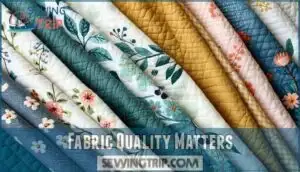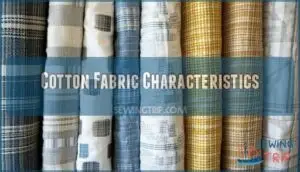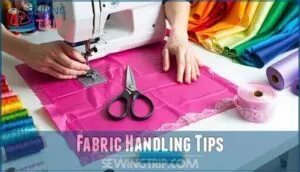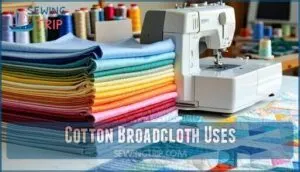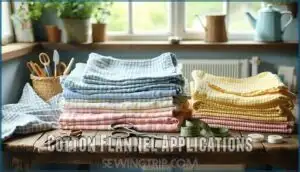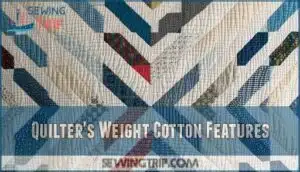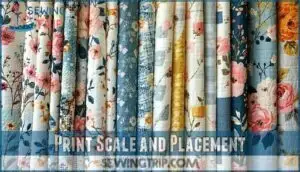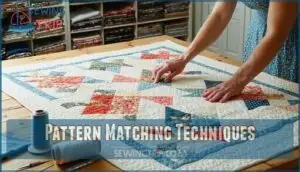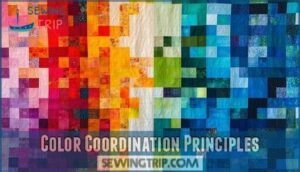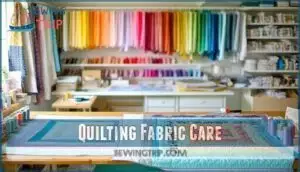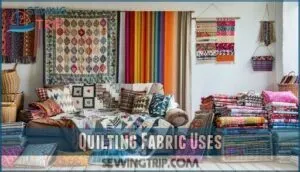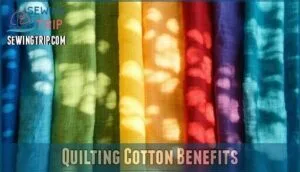This site is supported by our readers. We may earn a commission, at no cost to you, if you purchase through links.
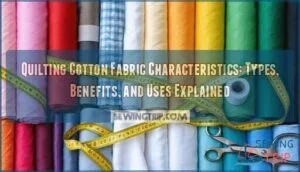
It’s medium weight with a tight weave, which means it’s strong yet easy to handle. You’ll appreciate its vibrant patterns, thanks to colorfast dyes that hold up over time.
Prewashing is essential—cotton likes to shrink a bit, and this step keeps surprises at bay. It’s breathable, which makes it comfortable, whether on a quilt top or a cozy throw.
Plus, it’s versatile; embellish it with embroidery, applique, or vibrant threads. Ready to start quilting? The fabric will do half the work!
Table Of Contents
Key Takeaways
- You’ll appreciate quilting cotton’s balanced weight, tight weave, and durability, making it perfect for structured designs and lasting quilts.
- Always prewash the fabric to prevent shrinkage and ensure vibrant, colorfast patterns that last through many washes.
- Pick high-quality, 100% quilter’s weight cotton with at least a 200-thread count for durability, smooth texture, and crisp details.
- Its breathability and hypoallergenic properties make it comfortable, versatile, and ideal for projects like quilts, clothing, and home decor.
Fabric Quality Matters
In the context of quilting cotton, fabric quality isn’t just a preference—it’s the key to a durable, beautiful quilt.
Fabric quality is the foundation of every stunning quilt, blending durability, beauty, and lasting charm in every stitch.
From thread count to weave type and colorfastness, each detail directly affects your project’s look, feel, and longevity.
Thread Count Importance
Thread count is the heartbeat of quilting cotton, defining its fabric smoothness and long-term durability. A higher thread count means softer, tighter weaves and superior fabric quality.
- **Choose fabrics with 200+ thread count for lasting quilts.
- **Lower thread counts offer looser weaves.
- **High counts resist fraying.
- **Durable designs need fine-thread fibers.
- **Thread density boosts fabric characteristics.
Weave Types Explained
Weave types define quilting cotton’s texture and performance.
A plain weave offers simplicity and durability, ideal for most projects.
Twill weave adds diagonal patterns for flexibility and drape.
Satin weave delivers a smooth, luxurious feel, while basket weave enhances thickness.
Novelty weaves, like jacquard, add creative flair.
Each cotton weave suits specific designs, balancing style and functionality effortlessly, with a focus on durability and luxurious feel.
Colorfastness Techniques
Weaves might impact texture, but fabric colorfastness guarantees your quilt stays vibrant through every wash.
To master this:
- Test for bleed prevention with a soak test.
- Use fabric finishes to enhance dye setting.
- Opt for UV-resistant quilting cotton for lasting color.
- Always perform wash testing before sewing.
- Trust advanced dyeing techniques for superior color retention.
Choosing Right Fabric
When choosing fabric for your quilt, focus on details like print scale, block size, and overall aesthetic balance. These elements guarantee your design feels cohesive, functional, and visually appealing.
Print Scale Considerations
Picking the right print scale for quilting cotton is like assembling a puzzle—fabric patterns, design placement, and visual balance must align seamlessly.
Small prints work well for intricate blocks, while bold, larger patterns shine in open spaces.
Focus on fabric layout and design continuity to avoid mismatched seams and corners, bringing harmony to every quilted masterpiece.
Quilt Block Size Balance
Matching quilt block size with cotton prints prevents a chaotic look.
Small blocks work best with tiny designs, while bold patterns suit larger pieces.
Here’s how to balance:
- Align fabric layout with your block dimensions.
- Use uniform block sizes for design continuity.
- Promote visual harmony across blocks.
- Consider fabric width when planning cuts.
- Match seam alignment for polished quilting projects.
Aesthetic Fit Principles
Achieving design harmony in quilting means paying attention to fabric aesthetics and color choices that complement your vision.
Focus on visual balance by aligning fabric textures and color coordination within your quilt blocks.
Seam alignment and thoughtful fabric layout guarantee design continuity.
Always consider how patterns flow together, creating a cohesive look that celebrates beautiful fabric textures and color continuity.
Consider breathability and comfort when selecting fabrics for quilting projects.
Cotton Fabric Characteristics
When you’re working with quilting cotton, understanding its characteristics can help you make better fabric choices.
Factors like long staple fibers, high thread counts, and breathability guarantee your quilts turn out durable, comfortable, and visually stunning.
Long Staple Cotton Benefits
Long-staple cotton is the superhero of quilting cotton.
Long-staple cotton delivers unmatched softness, strength, and durability, making every quilt a masterpiece built to last.
Its fibers bring enhanced softness and lasting quality to your projects.
You’ll also enjoy:
- Fiber Strength: Resists wear, tear, and keeps quilts longlasting.
- Reduced Pilling: Guarantees a smoother surface over years of use.
- Improved Drape: Adds elegance and flow to quilts effortlessly.
Invest in better cotton quality for standout results!
High Thread Count Advantages
A higher thread count isn’t just a fancy buzzword—it’s the secret sauce for premium quilting cotton.
It enhances softness, durability, and weave tightness, letting you create quilts with finer details and sharper print clarity.
High thread-count cotton showcases superior quality, feeling luxurious yet sturdy, perfect for fabric weave projects that demand both beauty and reliability.
Breathability Factors
A high thread count doesn’t just mean a smoother fabric – it also impacts cotton’s breathability.
Better fiber structure and tighter weave density allow for improved air permeability, keeping body temperature regulated.
Quilting cotton excels here: its moisture-wicking properties draw sweat away, while the fabric weave guarantees steady airflow.
It’s like your quilt breathes with you!
Fabric Handling Tips
Handling quilting cotton requires attention to detail to guarantee clean cuts, smooth seams, and vibrant designs.
With a few key techniques, like pre-washing and careful pressing, you can make every piece a perfect match for your quilt.
Pre-Washing Procedures
Prewashing cotton isn’t optional—it’s a quilter’s secret weapon.
To stop shrinkage or color bleeding, follow these steps:
- Pre-Treatment Soak: Soak fabric in cold water to remove sizing.
- Gentle Wash: Use mild detergent to maintain fabric integrity.
- Dry Slowly: Air-dry or low-heat tumble for best results.
This guarantees fabric shrinkage is controlled, protecting your masterpiece!
Many quilters prefer to shop for supplies before starting a new project.
Cutting and Sewing Guidelines
After pre-washing, smooth fabric grain for precise cuts. Accurate cutting keeps your quilting cotton cleanly aligned with the fabric layout.
Stick to a standard seam allowance—usually 1/4 inch—for consistency. Use sharp needles appropriate for quilting to prevent snags.
Consider using specialized quilting tools for best results. Adjust stitch length around 2.5 mm for durability.
Pattern matching? Keep designs flowing seamlessly across blocks for polished results.
Pressing and Seam Finishing
Pressing your seams is like giving your quilt that final salon touch—it elevates everything.
Use these tips to lock in perfection:
- Press seams open or to one side, based on design.
- Stabilize trouble areas with fabric stabilizers.
- Align corners sharply using pressing techniques.
- Finish raw edges with neat seam finishes.
- Watch your seam allowance—an iron can reshape quilting cotton.
This will help ensure your quilt looks its best, with perfection in every detail.
Quilting Fabric Types
When you’re choosing quilting fabric, understanding the different types can help you match the material to your project’s needs.
From versatile cotton broadcloth to cozy flannel and durable quilter’s weight cotton, each type offers unique characteristics that enhance both functionality and design.
Cotton Broadcloth Uses
Cotton broadcloth is a versatile gem for quilting projects.
Its smooth texture shines in Broadcloth Quilt Tops, garments, and decor.
Handy for structured quilt blocks and Broadcloth Projects, it’s also perfect for easy-to-sew crafts or lining materials.
| Feature | Use |
|---|---|
| Smooth texture | Broadcloth Quilt Tops |
| Crisp appearance | Broadcloth Garments |
| Breathable fabric | Broadcloth Decor |
| Durable material | Broadcloth Durability |
Cotton Flannel Applications
Perfect for baby blankets, pajama making, and winter apparel, cotton flannel is a versatile wonder.
Its soft, fuzzy texture brings warmth to cozy crafts like quilts and home accessories.
This quilting cotton pairs well with cotton batting, adding durability to quilting projects.
Whether for comfort or style, this cotton fabric is a go-to for crafting cold-weather essentials.
Quilter’s Weight Cotton Features
Quilter’s weight cotton is the gold standard for quilting, offering perfect weight advantages for durability and easy handling.
Its fine weave stability guarantees designs won’t distort, while the texture benefits add a soft yet sturdy feel.
With premium fiber content, this cotton fabric stands up to frequent use and washing, keeping print durability intact for years of cherished quilts.
Design and Aesthetics
In the context of design and aesthetics in quilting, your fabric choices are just as important as your sewing skills.
From aligning patterns to coordinating colors, achieving a cohesive and visually pleasing quilt requires careful consideration and a keen eye for detail, which involves complete concepts such as understanding color theory and pattern alignment.
Print Scale and Placement
Your quilt’s charm hinges on balancing print scale and design placement.
Oversized fabric prints might overshadow smaller quilt blocks, while tiny patterns can lose visual interest.
Pay attention to design direction for a cohesive fabric layout.
Prioritize visual balance and seam alignment to guarantee quilting fabric aesthetics shine.
Thoughtful planning keeps your quilt lively and polished!
Pattern Matching Techniques
When tackling pattern matching, focus on precision.
Start with these steps:
- Fabric Layout Matters: Arrange prints, like floral or geometric designs, to guarantee seamless design continuity.
- Corner Matching Basics: Align prints at seams and corners for a professional look.
- Print Placement Strategy: Adjust fabric alignment to highlight key patterns, complementing the quilt’s overall aesthetic.
Take it slow—it’s worth it!
Color Coordination Principles
Balancing color choices makes your design aesthetic shine.
Use color theory for a cohesive fabric palette, blending hues that harmonize beautifully.
Value contrast adds depth and keeps your quilt lively.
Experiment with tone harmony to maintain visual interest, picking color schemes that follow current trends.
Smart hue selection guarantees your patterns pop without overpowering.
Thoughtful coordination creates timeless quilts.
Achieving this also requires understanding fabric grain to make a beautifully designed and visually interesting quilt.
Quilting Fabric Care
Taking care of quilting fabric isn’t complicated, but it requires attention to detail to keep your projects looking their best.
By using gentle washing techniques, proper storage, and fabric-safe detergents, you can preserve the color, texture, and longevity of your quilts.
Washing and Drying Instructions
Laundry day doesn’t have to be stressful! Opt for a gentle cycle with cold water to keep colors vibrant and fabrics intact. Use a mild detergent to avoid harsh chemicals.
For drying, low heat is your best friend—protects against shrinkage and wrinkles. Iron on the right settings for a crisp finish.
Understanding fabric grain impacts quilt block stability is important.
- Use cold water for washing.
- Low heat prevents fabric damage.
- Mild detergent preserves quality.
Storage and Maintenance Tips
Keep stored fabrics dust-free by using breathable covers or bins.
Fold neatly using folding techniques to avoid creases.
Control humidity with a dehumidifier to prevent mildew, and deter moths with cedar chips for insect prevention.
Always follow fabric care instructions.
Stain removal on stored quilts can be tricky, so make certain fabrics are clean after fabric washing and drying, which helps with insect prevention and prevents damage from mildew.
Gentle Detergent Recommendations
When choosing a gentle detergent for your quilting cotton, keep it simple to protect your fabric.
Look for products with these features:
- Detergent Ingredients: Avoid harsh chemicals.
- pH Levels: Opt for pH-neutral formulas.
- Enzyme Considerations: Skip enzymes that can weaken fibers.
To find appropriate solutions, consider using a specialized quilting cleanser.
- Scent Sensitivity: Select unscented options if needed.
- Water Temperature: Pair mild detergent with cool water.
Environmental Impact
When you think about quilting cotton, it’s easy to overlook its environmental footprint, but every fabric choice you make has an impact.
From sourcing sustainable materials to managing waste and reducing energy use, understanding these factors helps you create beautiful quilts with a greener conscience.
Sustainable Sourcing Methods
Sustainable sourcing in cotton production matters.
Organic cotton reduces pesticide usage, promoting healthier soil and water conservation. Recycled fibers support environmental impact goals by reducing waste.
Eco-friendly dyes keep waterways cleaner, while Fair Trade guarantees ethical practices. Local production slashes transport emissions.
These methods create quilts you can cherish, knowing they blend beauty with responsible choices and support environmental impact goals.
Waste Management Strategies
Waste from cotton production adds up fast, so let’s tackle it head-on:
- Repurpose leftover fabric scraps for smaller projects.
- Explore recycling cotton fibers into new textiles.
- Reduce fabric waste with precise cutting and thoughtful pattern layout.
- Opt for biodegradable fabric options to reduce landfill impact.
- Choose sustainable dyeing practices to mitigate environmental damage from water and pesticide usage.
To further minimize waste, consider implementing lean manufacturing principles within the production process to achieve environmental benefits and reduce waste.
Energy Consumption Reduction
Reducing energy use starts with efficient manufacturing, using renewable energy sources like solar power for cotton production.
Opt for sustainable dyes, which cut water usage and minimize the environmental impact.
Transportation impact shrinks when materials are sourced locally, while sustainable sourcing reduces waste.
Small changes like these align with broader environmental considerations and make quilting fabrics kinder to the planet, promoting a more environmental approach.
Quilting Fabric Uses
You’ll find quilting cotton is more than just a staple for making stunning quilts; it’s incredibly versatile for projects like bedding, clothing, and upholstery.
Its durability, softness, and vibrant designs make it perfect for both functional and decorative uses around your home, with versatile applications in various areas.
Bedding and Home Decor
For bedding and home decor, quilting cotton shines thanks to its versatility and charm.
It’s perfect for bedroom aesthetics and living room textiles alike.
Create quilting magic with cozy quilts or decorative pillows that showcase your personality.
Add seasonal decor touches, swapping patterns to match the weather.
Turn cotton fabric into stunning quilts or inspiring textile art pieces!
- Soft quilts for dreamy comfort
- Decorative pillows adding flair
- Seasonal decor for festive vibes
- Textile art elevating any room
Clothing and Accessories
With quilting cotton, you can explore garment applications and accessory design in endless ways.
Its soft, breathable texture works wonderfully for light clothing like skirts or shirts.
Accessories? Think tote bags or scarves turned into wearable art!
Plus, cotton fabric takes fabric dyeing well, keeping up with fashion trends.
Your fabric choice elevates sewing projects into both practicality and creative expression.
Furniture and Upholstery
Quilting cotton isn’t just for quilts—it shines in furniture and upholstery, too.
Its fabric durability and soft texture make it comfy, while stain resistance keeps it practical.
Lightweight yet sturdy, it balances design integration with cost considerations.
Need a pop of personality? Quilting cotton offers endless prints, blending style with function seamlessly in any upholstery project.
Quilting Cotton Benefits
You’ll love how quilting cotton combines durability, softness, and hypoallergenic properties to create fabrics that stand the test of time.
Its pliable texture makes it a breeze to work with, whether you’re piecing blocks or stitching intricate patterns.
Durability and Longevity
Great quilting cotton’s durability depends on fiber quality, weave strength, and color retention.
Long-lasting fabrics handle frequent usage impact without losing shape or vibrancy. Seam reinforcement guarantees stability, even in heavy-use quilts.
Strong weaves and premium materials create exceptional fabric longevity. You’ll appreciate how well it holds up after endless washes, making your project a reliable, cherished keepsake, with vibrancy.
Hypoallergenic Properties
If sensitive skin or cotton allergies are a concern, quilting cotton’s hypoallergenic properties make it a natural choice.
Its chemical-free, natural fibers reduce skin irritation, especially in baby quilts.
Here’s why it’s great for allergy reduction:
- Breathable fibers keep skin comfortable.
- No harsh chemicals mean fewer reactions.
- Gentle on delicate skin, perfect for little ones, making it ideal for allergy reduction.
Softness and Pliability Factors
Softness matters because it makes cotton fabric comfortable and easy to work with.
Fiber construction and weave influence how smooth the fabric feels, while density adds stability.
Chemical treatments and finishing processes guarantee quilting cotton maintains its pliable, cozy texture, and it is the ideal balance—strong enough for lasting use, yet soft enough to shape beautifully in any project.
Frequently Asked Questions (FAQs)
What is the difference between quilting cotton and regular cotton fabric?
Quilting cotton is sturdy, tightly woven, and designed for durability, while regular cotton varies in weight and weave.
You’ll notice quilting cotton holds shape better, making it ideal for projects needing structure, like vibrant, lasting quilts.
What kind of cotton fabric is used for quilting?
You’ll typically use high-quality, 100% cotton, called quilter’s weight cotton.
It’s durable, smooth, and easy to work with, offering crisp details and vibrant prints.
Plus, its breathable texture keeps your projects comfy and long-lasting.
What is the difference between quilting cotton and cotton poplin?
Quilting cotton is thicker, durable, with a matte finish, perfect for crafting quilts.
Cotton poplin is lighter, smoother, with a slight sheen, making it ideal for clothing.
Poplin’s tighter weave creates a crisper texture.
What are the best quilting cotton weight options?
Choosing quilting cotton with a medium weight (4-5 oz per square yard) guarantees the right balance of durability and flexibility.
It’s perfect—light enough for easy stitching, yet sturdy enough to handle frequent washes, making it a great choice for quilting projects that require durability.
How does fabric texture impact quilt designs?
The way fabric feels can change a quilt’s vibe completely.
Slick textures boost modern designs, while softer, cozier feels fit traditional ones.
Balancing texture adds dimension, making your quilt both visually appealing and touch-friendly.
Can quilting cotton be dyed at home?
Dyeing quilting cotton at home is a breeze!
With proper preparation—pre-washing to remove sizing—and high-quality fiber-reactive dyes, you’ll create vibrant, custom colors.
Just wear gloves, follow instructions, and embrace the creative mess!
How do seasonal trends influence fabric choices?
Seasonal trends inspire your fabric choices by spotlighting colors, patterns, and textures.
Spring may call for florals, while winter favors warm, heavier fabrics.
Following trends keeps your quilts stylish and perfectly suited for each season.
Are organic cotton fabrics suitable for quilting?
Think of organic cotton as the eco-friendly hero of quilting.
It’s soft, durable, and hypoallergenic, making it ideal for sensitive skin.
Plus, its breathability and vibrant dye absorption bring your quilt designs to life beautifully, with hypoallergenic properties.
Conclusion
Quilting cotton fabric shines with strength, structure, and style, making it a go-to choice for crafters.
Its balanced weight, breathable texture, and colorfast designs guarantee durability and ease of use.
From mastering prewashing to selecting the perfect thread count, understanding quilting cotton fabric characteristics elevates your creations.
Whether piecing intricate blocks or embellishing with vibrant threads, this versatile fabric supports your artistic vision.
Enter quilting confidently—your fabric choice already puts you a stitch ahead!

